Gay icon
A gay icon is a public figure who is highly regarded by the LGBT community, often for their support of LGBT rights and activism, or for being a prominent member of the community themselves. Media organizations such as GLAAD routinely recognize such figures for their contributions to LGBT causes.
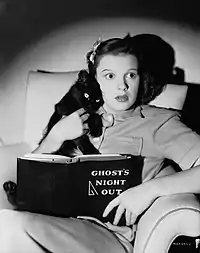
The most widely recognized gay icons are often celebrities who garnered large LGBT fanbases, such as Judy Garland, Marlene Dietrich,[2] Nelson Mandela,[3] Marlon Brando,[4] Harvey Milk,[5] James Dean,[6] George Takei,[7] Ian McKellen,[8] Freddie Mercury,[9] Elton John,[10] John Waters,[11] Elizabeth Taylor,[12] Barbra Streisand,[13] David Bowie,[14] Stephen Fry,[15] Donna Summer,[16] Cyndi Lauper,[17] Harvey Fierstein,[18] Prince (musician),[19] Madonna, Ellen DeGeneres,[20] Village People,[21] Boy George,[22] George Michael,[23] Janet Jackson, Lady Gaga, Lana Del Rey,and Cher. However, the term is also applied to politicians, authors, and other historical figures deemed relatable to LGBT causes.
Many gay icons are celebrities in the entertainment industry, but can also include figures in politics, history, sports, literature, and other mediums. Prominent entertainers considered to be gay icons often incorporate themes of acceptance, self-love, and sexuality in their work. Gay icons of all orientations have acknowledged the role that their gay fans have played in their success, including legends like, Bette Midler, Liza Minnelli, and Diana Ross to stars of the '90s and early '00s such as Geri Halliwell, Mariah Carey, Kylie Minogue, Neil Patrick Harris,[24] David Beckham,[25] Justin Timberlake,[26] Ben Cohen (rugby union),[27] Christina Aguilera, Jake Gyllenhaal,[28] Beyoncé,[29] Britney Spears, Macklemore[30] and Adam Lambert.[31] More recently stars such as Charli XCX, Lana Del Rey, Miley Cyrus and Ariana Grande have been seen as gay icons due to their stance on LGBT rights and their campy nature. Politicians considered to be gay icons typically attain their status in the LGBT community for consistently supporting and advocating for LGBT rights.
Historical figures
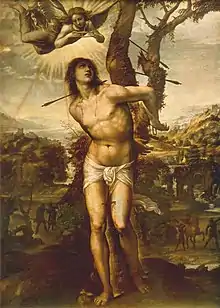
Sappho of Lesbos
Sappho of Lesbos was an Archaic Greek poet known for composing sentimental lyrics about women. Perceived homoerotism in her poems lead to her becoming a symbol for lesbianism,[32] with her name and home island inspiring the terms sapphic and lesbian respectively. Her sexuality, and the themes in her poetry have been extensively discussed and reinterpreted by scholars.[33]
Saint Sebastian
The 3rd century Christian martyr Saint Sebastian is one of the earliest known gay icons,[34] due to his depiction in artwork as a beautiful, agonied young man.[35] Historian Richard A. Kaye states that "Contemporary gay men have seen in Sebastian at once a stunning advertisement for homosexual desire (indeed, a homoerotic ideal), and a prototypical portrait of a tortured closet case."[36]
In the 1890s, Irish poet Oscar Wilde, himself also called a gay icon,[37] was incarcerated and exiled for his sexuality, and adopted the pseudonym "Sebastian Melmoth" after the saint.[38] Gay playwright Tennessee Williams used the saint's name for the martyred character Sebastian in his 1957 play, Suddenly, Last Summer.[39]
Marie Antoinette
Prior to the French Revolution, opponents of the French monarchy regularly circulated pornographic propaganda alleging that Marie Antoinette was engaged in a lesbian relationship with the Princesse de Lamballe. While the rumors of Antoinette's sexuality were unfounded, they lead to her being interpreted as an early lesbian icon in works by gay authors, such as Radclyffe Hall's The Well of Loneliness (1928) and Jean Genet's The Maids (1947).[40]
Modern celebrities
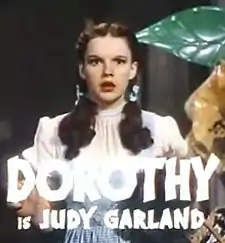
Judy Garland
American singer and actress Judy Garland was immensely popular among gay men due to her camp sensibilities, and is considered "the quintessential pre-Stonewall gay icon".[41]
In the 1950s, the phrase "friend of Dorothy" became used as a slang term for homosexuals. This term is attributed both to American author and fellow gay icon Dorothy Parker, and to Garland's prominent role as Dorothy Gale in The Wizard of Oz.[42]
Madonna
Pop music singer Madonna became a preeminent gay icon of the 1980s.[43][44][45] The Advocate's Steve Gdula commented that "back in the 1980s and even the early 1990s, the release of a new Madonna video or single was akin to a national holiday, at least among her gay fans."[45] Gdula also stated that during this period, concurrent with the rise of the AIDS epidemic, "when other artists tried to distance themselves from the very audience that helped their stars to rise, Madonna only turned the light back on her gay fans and made it burn all the brighter."[45]
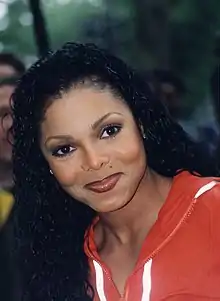
Janet Jackson
Janet Jackson garnered a substantial LGBT following during the 1990s. Her sixth studio album The Velvet Rope (1997).[46][47][48] The album was honored by the National Black Lesbian and Gay Leadership Forum and received the award for Outstanding Music Album at the 9th Annual GLAAD Media Awards in 1998 for its songs that dealt with sexual orientation and homophobia.[49] On April 26, 2008, she received the Vanguard Award—a media award from the Gay & Lesbian Alliance Against Defamation—to honor her work in the entertainment industry in promoting equality for LGBT people.[49] GLAAD President Neil G. Giuliano commented, "Ms. Jackson has a tremendous following inside the LGBT community and out, and having her stand with us against the defamation that LGBT people still face in our country is extremely significant."[49][50]
Responses
Many celebrities have responded positively to being regarded as gay icons, several noting the loyalty of their gay fans. Eartha Kitt and Cher have credited gay fans with keeping them going at times when their careers had faltered.[51]
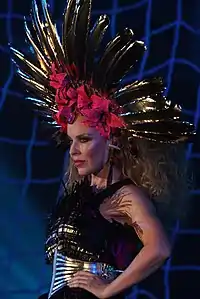
Kylie Minogue has acknowledged the perception of herself as a gay icon and has performed at such events as the Sydney Gay and Lesbian Mardi Gras. Asked to explain the reason for her large gay fanbase, Minogue replied, "It's always difficult for me to give the definitive answer because I don't have it. My gay audience has been with me from the beginning ... they kind of adopted me." She noted that she differed from many gay icons who were seen as tragic figures, with the comment, "I've had a lot of tragic hairdos and outfits. I think that makes up for it!"[52]
Lady Gaga has acknowledged and credited her gay following for launching then supporting her career stating, among other examples, "When I started in the mainstream it was the gays that lifted me up", and that "because of the gay community I'm where I am today." As a way to thank her gay audience for allowing her to perform her first album in gay clubs before she was invited to perform at straight ones, she often debuted her new albums at gay clubs. Along her career, she also dedicated a MuchMusic Video Award win, as well as her Alejandro music video, to gay people, frequently praised her gay entourage for the positive impact they had on her life and often gave a place to different queer crowds in her songs, performances, music videos as well as in the visuals of her make up line. Lady Gaga is known for her fights as an LGBT activist and attended numerous LGBT events such as Prides and Stonewall day.[53][54][55][56][57][58][59]
Madonna has acknowledged and embraced her gay following throughout her career, even making several references to the gay community in her songs or performances, and performed at several gay clubs. She has declared in interviews that some of her best friends are gay and that she adores gay people and refers to herself as "the biggest gay icon of all times."[60] She also has been quoted in television interviews in the early 1990s as declaring the "big problem in America at the time was homophobia."
Geri Halliwell has consistently acknowledged and accepted her status as a gay icon throughout her career as both a solo artist and member of the Spice Girls, describing a "kinship" with the gay community and her love and respect for her LGBTQ fans.[61][62]
See also
References
- Walters, Barry (October 13, 1998). An icon for the ages. The Advocate. p. 87.
- "The 12 Greatest Female Gay Icons of All Time; Also: Nathan & Matthew back together on Broadway". www.out.com. 2014-08-25. Retrieved 2021-01-22.
- "Gay Icons | The 18 Greatest Gay Male Icons Of Our Generation". rukkle. 2015-10-28. Retrieved 2021-01-22.
- "Gay Icons | The 18 Greatest Gay Male Icons Of Our Generation". rukkle. 2015-10-28. Retrieved 2021-01-22.
- "Gay Icons | The 18 Greatest Gay Male Icons Of Our Generation". rukkle. 2015-10-28. Retrieved 2021-01-22.
- "Gay Icons | The 18 Greatest Gay Male Icons Of Our Generation". rukkle. 2015-10-28. Retrieved 2021-01-22.
- "Gay Icons | The 18 Greatest Gay Male Icons Of Our Generation". rukkle. 2015-10-28. Retrieved 2021-01-22.
- "Gay Icons | The 18 Greatest Gay Male Icons Of Our Generation". rukkle. 2015-10-28. Retrieved 2021-01-22.
- "Hollywood's most famous gay icons | Gallery". Wonderwall.com. 2019-08-01. Retrieved 2021-01-22.
- "Hollywood's most famous gay icons | Gallery". Wonderwall.com. 2019-08-01. Retrieved 2021-01-22.
- "Gay Icons | The 18 Greatest Gay Male Icons Of Our Generation". rukkle. 2015-10-28. Retrieved 2021-01-22.
- "Hollywood's most famous gay icons | Gallery". Wonderwall.com. 2019-08-01. Retrieved 2021-01-22.
- "Hollywood's most famous gay icons | Gallery". Wonderwall.com. 2019-08-01. Retrieved 2021-01-22.
- "Hollywood's most famous gay icons | Gallery". Wonderwall.com. 2019-08-01. Retrieved 2021-01-22.
- "Gay Icons | The 18 Greatest Gay Male Icons Of Our Generation". rukkle. 2015-10-28. Retrieved 2021-01-22.
- "Hollywood's most famous gay icons | Gallery". Wonderwall.com. 2019-08-01. Retrieved 2021-01-22.
- "Hollywood's most famous gay icons | Gallery". Wonderwall.com. 2019-08-01. Retrieved 2021-01-22.
- "Gay Icons | The 18 Greatest Gay Male Icons Of Our Generation". rukkle. 2015-10-28. Retrieved 2021-01-22.
- "Hollywood's most famous gay icons | Gallery". Wonderwall.com. 2019-08-01. Retrieved 2021-01-22.
- "Hollywood's most famous gay icons | Gallery". Wonderwall.com. 2019-08-01. Retrieved 2021-01-22.
- "Hollywood's most famous gay icons | Gallery". Wonderwall.com. 2019-08-01. Retrieved 2021-01-22.
- "Hollywood's most famous gay icons | Gallery". Wonderwall.com. 2019-08-01. Retrieved 2021-01-22.
- "Gay Icons | The 18 Greatest Gay Male Icons Of Our Generation". rukkle. 2015-10-28. Retrieved 2021-01-22.
- "Gay Icons | The 18 Greatest Gay Male Icons Of Our Generation". rukkle. 2015-10-28. Retrieved 2021-01-22.
- "Gay Icons | The 18 Greatest Gay Male Icons Of Our Generation". rukkle. 2015-10-28. Retrieved 2021-01-22.
- "Gay Icons | The 18 Greatest Gay Male Icons Of Our Generation". rukkle. 2015-10-28. Retrieved 2021-01-22.
- "Gay Icons | The 18 Greatest Gay Male Icons Of Our Generation". rukkle. 2015-10-28. Retrieved 2021-01-22.
- "Gay Icons | The 18 Greatest Gay Male Icons Of Our Generation". rukkle. 2015-10-28. Retrieved 2021-01-22.
- "The 12 Greatest Female Gay Icons of All Time; Also: Nathan & Matthew back together on Broadway". www.out.com. 2014-08-25. Retrieved 2021-01-22.
- "Gay Icons | The 18 Greatest Gay Male Icons Of Our Generation". rukkle. 2015-10-28. Retrieved 2021-01-22.
- "Gay Icons | The 18 Greatest Gay Male Icons Of Our Generation". rukkle. 2015-10-28. Retrieved 2021-01-22.
- Rayor, Diane; Lardinois, André (2014). Sappho: A New Translation of the Complete Works. Cambridge: Cambridge University Press. pp. 2–9. ISBN 978-1-107-02359-8.
- Mendelsohn, Daniel. "How Gay Was Sappho?". The New Yorker. Retrieved 2020-12-21.
- "Subjects of the Visual Arts: St. Sebastian". glbtq.com. 2002. Archived from the original on September 1, 2007. Retrieved August 1, 2007.
- "Arrows of desire: How did St Sebastian become an enduring, homo-erotic". The Independent. 2011-10-23. Retrieved 2020-12-20.
- Kaye, Richard A. (1996). "Losing His Religion: Saint Sebastian as Contemporary Gay Martyr". Outlooks: Lesbian and Gay Sexualities and Visual Cultures. Peter Horne and Reina Lewis, Eds. New York: Routledge. 86: 105. doi:10.4324/9780203432433_chapter_five.
- AnOther (2016-09-02). "How Oscar Wilde Paved the Way for Gay Rights in the Arts". AnOther. Retrieved 2020-12-20.
- Wilde, Oscar, 1854-1900. (2000). The complete letters of Oscar Wilde. Holland, Merlin., Hart-Davis, Rupert, 1907-1999. (1st ed.). New York: Henry Holt. ISBN 0-8050-5915-6. OCLC 45172929.CS1 maint: multiple names: authors list (link)
- "Tiny Rep presents Suddenly, Last Summer" (PDF). Archived from the original (PDF) on September 28, 2007. Retrieved August 1, 2007.
- Fraser, Antonia (2001). Marie Antoinette: The Journey. New York: Anchor. p. 449. ISBN 0-385-48949-8.
- Bronski, Michael (1984). Culture Clash: The Making of Gay Sensibility. South End Press. p. 104. ISBN 0-89608-217-2.
- Cage, Ken; Evans, Moyra (2003). Gayle: The Language of Kinks and Queens, A History and Dictionary of Gay Language in South Africa. Jacana Media. p. 10. ISBN 1-919931-49-X.
- Cross, Mary (2004). Madonna: A Biography. Canongate U.S. ISBN 0-313-33811-6.
- Bowman, Edith (May 26, 2007). "BBC World Visionaries: Madonna Vs. Mozart". BBC News. Archived from the original on May 25, 2008. Retrieved May 12, 2008.
In 2000, Guinness World Records listed Madonna as the most successful female recording artist of all time.
- Gdula, Steve (November 11, 2005). "Happy Madonna day!". Archived from the original on November 19, 2006. Retrieved July 9, 2008.
- Goldberg, M. (May 2, 1991). "The Jacksons score big". Rolling Stone. p. 32. ISSN 0035-791X.
- "Janet Jackson Hits Big; $80 Million Record Deal". Newsday. January 13, 1996. pp. A02.
- McCormick, Neil (October 18, 1997). "The Arts: Give her enough rope... Reviews Rock CDs". The Daily Telegraph. p. 11.
- McCarthy, Marc (April 1, 2008). "Janet Jackson to be Honored at 19th Annual GLAAD Media Awards in Los Angeles". GLAAD. Archived from the original on April 9, 2008. Retrieved April 1, 2008.
- "La Toya Jackson Learns Life's Lessons". gaywired.com. June 2005. Archived from the original on 2005-10-23. Retrieved December 21, 2007.
- Rutledge, Leigh W. (2003). The Gay Book of Lists, 3rd Edition. Los Angeles, CA: Alyson Publications. pp. 87–88. ISBN 1-55583-740-9.
- Ives, Brian; Bottomley, C. (February 24, 2004). "Kylie Minogue: Disco's Thin White Dame". VH1.com. Retrieved January 21, 2007.
- Nichols, James Michael (2017-03-25). "Lady Gaga: Gay Men 'Helped Me Become A Woman'". HuffPost. Retrieved 2019-12-24.
- "Lady Gaga: 'I Really Wouldn't Be Here Without the Gay Community'". pride.com. 2018-09-10. Retrieved 2019-12-24.
- "Why gays love Gaga". www.nationthailand.com.
- "The Lady Is a Vamp". out.com. 2017-03-28. Retrieved 2019-12-24.
- Mandell, Andrea. "Lady Gaga and her stylist have a 4 a.m. kind of friendship". USA TODAY. Retrieved 2019-12-24.
- "12 Times Lady Gaga Showed Love for the LGBTQ Community". Billboard. Retrieved 2019-12-24.
- "Lady Gaga Honored For LGBT Work". Look to the Stars. 2011-03-23. Retrieved 2019-12-24.
- "Madonna: 'I hope I'm still a gay icon'". Gay.com. October 26, 2005. Archived from the original on October 28, 2005. Retrieved August 1, 2007.
- Crowley, Patrick. "Geri Halliwell Premieres George Michael Tribute, Talks 'Spice World' & LGBTQ Fanbase". Billboard. Retrieved 10 January 2021.
- "Attitude's Honourary Gay Award: Geri Horner". Attitude. Retrieved 10 January 2021.
Books
- Gay Icons: The (Mostly) Female Entertainers Gay Men Love, Georges-Claude Guilbert (2018). ISBN 978-1-4766-7433-9
- The Culture of Queers, Richard Dyer (2002). ISBN 0-415-22376-8
- Frightening the Horses: Gay Icons of the Cinema, Eric Braun (2002). ISBN 1-903111-10-2
- 20th Century Icons-Gay, Graham Norton (2001). ISBN 1-899791-77-9
- Gay histories and cultures, George E. Haggerty (2000). ISBN 0-8153-1880-4
External links
- GLBT Historical Society
- Christina up close
- Sophie Morris. From the tragic to the bland // New Statesman, August 1, 2005
- "Pink doesn't mean fluffy" John Howard. The Independent, (UK), August 4, 2005
- French Gay Icons: Ysa Ferrer